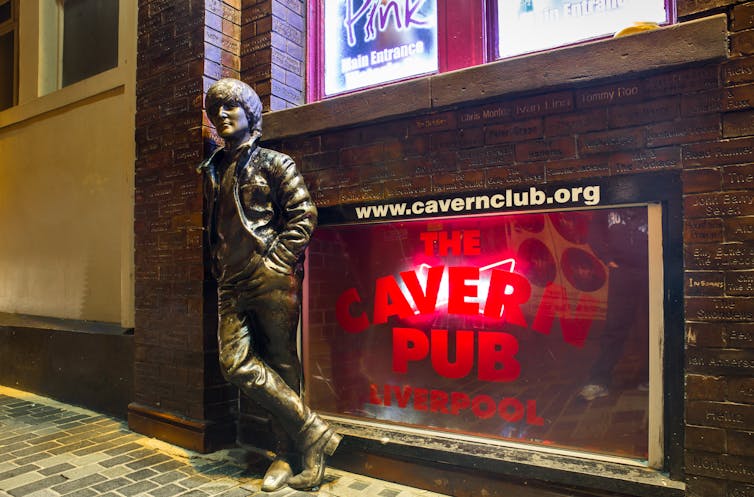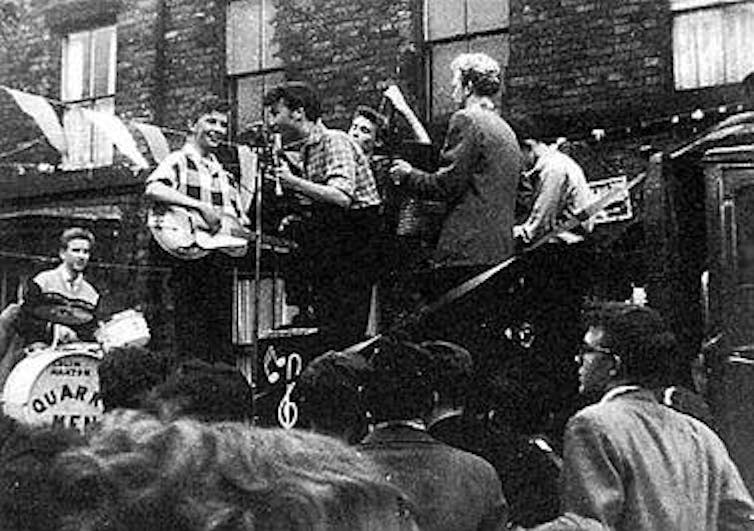19.7.20
RBSA Friends Online Exhibition 2020
14.7.20
12.7.20
Poor Mother - Artist Bio(me)
11.7.20
7.7.20
Arts rescue package: don't forget small venues – they're where big stars learned their trade

Icons – and gigs – come in all shapes and sizes. July 6 marks the anniversary of the day that Paul McCartney and John Lennon first met at Woolton Fête in 1957. Sixty-three years later McCartney has played at massive and historic events: Olympic ceremonies, Royal Jubilees, Live Aid and, of course, stadiums and arenas around the world.
In the precarious, socially distanced atmosphere of COVID-19 it’s becoming just about possible to imagine a small outdoor gathering such as Woolten Fête taking place again. But the timeframe for music venues reopening is less certain. This is a major concern – by McCartney’s own account, it’s the “grassroots clubs, pubs and music venues” that shaped his craft as a performer. As he said in 2016:
Artists need places to start out, develop and work on their craft and small venues have been the cornerstone for this.
COVID-19 and the lockdown have imperilled artistic activity and creative industries across the board – and the £1.57 billion rescue package from the UK chancellor of the exchequer, Rishi Sunak, offers much-needed breathing room for museums, venues, cinemas, galleries and theatres alike.
But much will depend on how this is administered – not just across the different art-forms but within these sectors: from the Royal Opera House to the small venues, including the Cavern and the Casbah Coffee Club where the Beatles cut their teeth. From the major cities to the smaller towns.

Given the scale of the crisis, resources are finite but it’s important, where possible, not to view it as a zero-sum game. A key feature of the relationship between the grassroots clubs, the concert halls and the arenas is interdependence – an ecology where diversity of venues, as well as music styles, provides not only a pathway for musical careers but a cultural system where the whole is greater than the sum of the parts.
Cultural and economic value
Oliver Dowden, the culture secretary, talks of preserving the “crown jewels”, such as the Royal Albert Hall, while the prime minister spoke of local venues. Both are vital. The grassroots sector has been described as the “research and development” arm of the music industries and without these spaces it will be hard to produce the McCartneys of the future. This is not just a question of star power.
Music is a significant contributor to the UK economy – around £5.2 billion per annum according to UK Music. And live music – at £1.1 billion in 2018 – is central to that. The days in which live performances were secondary to recordings have passed. Consumer spend on live music outpaced recordings in 2008 and the sector overall – to say nothing of individual careers – relies on the live experience.
To that end, the government’s announcement can be viewed as an investment as much as a bailout, urgently needed though it is. Nor do the economic figures tell the whole story. The UK Live Music Census of 2017 (which I worked on) demonstrated how venues are embedded into their localities, woven throughout the lives of audience members as well as musicians. As one respondent told us:
I feel part of something greater as I’ve shared something beautiful with a crowd, even if I haven’t spoken to them; it makes me feel like I’m part of a community.
Small venues were also the category that had been most visited by respondents to the audience survey (78% had attended one in the previous 12 months) and this foundation for local and national musical life means that “heritage” spreads out beyond storied concert halls like the Albert Hall. Local live music has been a focus of tourism as well as home consumption.
As the licensee of Camden Town’s Dublin Castle put it when explaining how the venue was simultaneously a community resource and a part of a bigger cultural picture:
We get people travelling from Japan who come to The Dublin Castle because they know that Amy Winehouse played there and she used to frequent the bar. And they sit down and they’re thinking ‘I’m drinking where she drank’. And I think that makes you feel that you’re part of that scene which you want to belong to.
Nurturing the grassroots
Despite its role in shaping Britain’s musical milieu, the grassroots sector hasn’t had it easy. Under pressure from urban development and gentrification, a spate of closures has led to the realisation that, once lost, these spaces are hard to replace.
The Music Venue Trust, which played a major role in lobbying for the recent injection of funds, did much to galvanise and give a more unified voice to what had hitherto been quite a disparate group of businesses – something that is, after all, a part of their appeal.
The imminent threat to hundreds of venues might be allayed, then, but they aren’t out of the woods yet. Brexit still looms on the horizon – and recent research has shown that the beyond the problems this may cause for touring musicians, there could also be knock-on effects from the cultural sector to local employment more widely.
A mapping exercise currently underway in Birmingham demonstrates the difficulty of disentangling the fates of local scenes, national industries and international networks. The chancellor’s rescue package is a vital first step in maintaining the global stepping stones from Woolten Fête to Shea Stadium. It’s important that it isn’t the last.![]()
Adam Behr, Lecturer in Popular and Contemporary Music, Newcastle University
This article is republished from The Conversation under a Creative Commons license. Read the original article.
5.7.20
Materiality - Online exhibition with 59 works on show from studying, emerging, and established artists
The exhibition is being hosted online here and there is also be an Instagram account that will feature works related to the theme from other artists, this will be used to promote the exhibition and provide an introduction to materiality within art.
"In this show, materiality is investigated through multiple mediums including video art, sculpture, ceramics, digital collage, painting, and jewellery. This broad approach to materiality allows the audience to reflect upon the range of avenues that artists pursue in order to decipher our material world. All works on show have been created with sensitive and intelligent consideration of material qualities and interactions. The artists shown in this exhibition live and work all around the world, their works have been brought together in order to show an international survey of the investigation of materiality within contemporary art. Relationships between works can be seen in each curated 'room', these images seemingly provide a real space that allows the viewer to investigate the works in relation to one another with an accurate sense of scale. This sense of union is of utmost importance to the show as each culture and country in which the artists work provides a rich and varied perception of a universal concept. There are 59 works on show from studying, emerging, and established artists."
How do artists imagine the world in 2050?| Tate
A Year in Art: 2050 is a two-room exhibition at Tate Modern exploring how visions of the future have taken shape in art across time. It brin...



